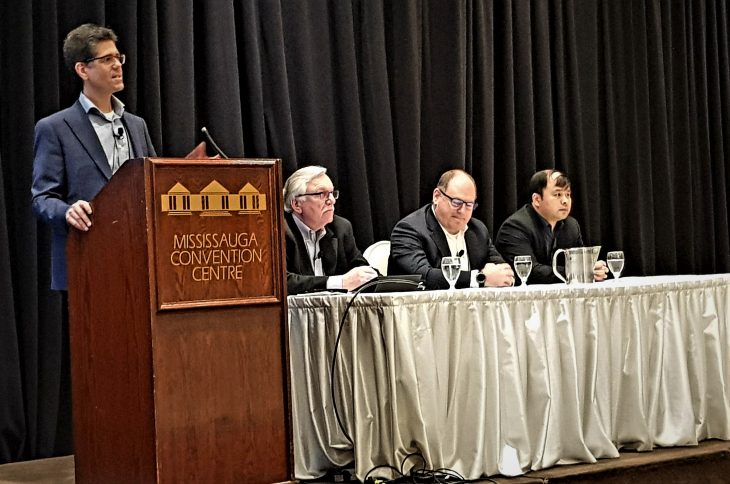
MISSISSAUGA – New technologies and access to vast quantities of data promise to create smart cities, which improve sustainability, create economic development, and enhance quality of life for people living and working in them. At Commtech East last week, a panel of industry experts (pictured) offered insight on what has to happen if our cities are to get smarter.
John Jung, executive director of Intelligence Community Forum (ICF) Canada, explained there are now about 200 cities all over the world the ICF has recognized as intelligent communities. He added there are likely thousands of additional cities which could be added to the list. Conversely, there are hundreds of cities in North America claiming they’re smart cities just because they have added some Wi-Fi zones. To become recognized as a smart city by the ICF, however, they must demonstrate how they are leveraging technologies to become better, caring and economically successful communities.
“Just because they have a physical connection doesn’t make them smart. They may have the infrastructure, but we’re looking at how are you actually using it?” said Jung.
Christopher Emery, senior director, technology and strategy at Rogers, said part of his role is to look ahead at how new technologies will impact his company. “Traditionally I think Rogers has played the role of being a connector. We provide connectivity, that is our core business today. But I think, as these applications get a little bit more sophisticated, our role in this has to change,” explained Emery. That includes keeping data safe, protecting privacy and stopping hackers.
He added it wasn’t very long ago when internet connectivity was limited to email exchanges. Now, “it has to be an industrial internet and has to be a very secure Internet with tremendous resiliency.”
For smart cities to thrive it’s crucial an ecosystem of IP stakeholders is developed, said Savio Lee, business lead, digital transformation at Ingram Micro. To make cities truly connected and smart will take many years since there remain many hurdles to leap. “In the last few years as much as 70% of the IP projects failed simply because of challenges associated with implementation in the physical world,” explained Lee.
Moderator Rob McCann, president of Clearcable Networks, asked the panel if smart city technologies can actually make cities more sustainable.
Emery said he believes smart city technologies can help by better managing traffic, which can result in less fossil fuels being used, for example. “Even 10 years ago, no one had ever heard of ways or the ability to have a car respond to time traffic management,” said McCann. “By using those tools, as a society, we’re reducing the amount of time we spend in cars to get to work. And we’re reducing emissions generated for us to do so.”
Lee said the key for cities to succeed in implementing smart solutions is to limit it to tackling one or two key problems. “The most successful use of smart technologies are when they are applied to specific problems, are cost effective and easy to deploy,” explained Lee.
“We have a role to play in helping connect disparate groups that might not otherwise be communicating with each other.” – Christopher Emery, Rogers
To make smart cities a reality in Canada, Rogers will need to build a network that can accommodate a far greater number of devices than are in use today, added Emery. To make that happen, small 5G wireless cells, for example, will need to be installed into street furniture, meaning Rogers must work more closely with municipalities.
“We have a role to play in helping connect disparate groups that might not otherwise be communicating with each other,” said Emery.
Jung noted it’s in the best interests of everyone to invest in smart city technologies because once implemented, operating costs decline. “Smart city technologies save money and allow it to be redirected to other projects like a new school playground,” noted Jung.
The panel members agreed in order for Canada’s cities to become smarter, new collaborations and sharing solutions must be encouraged at all levels of business and government.
“All of us need to take a little bit of time away from the day-to-day tasks to read an article or a blog. Investigate something, have a conversation with someone that you might not otherwise have had a conversation with to learn something new. Everyone in this room knows things are changing fast, technology changes, and then continues to accelerate,” said Emery.



